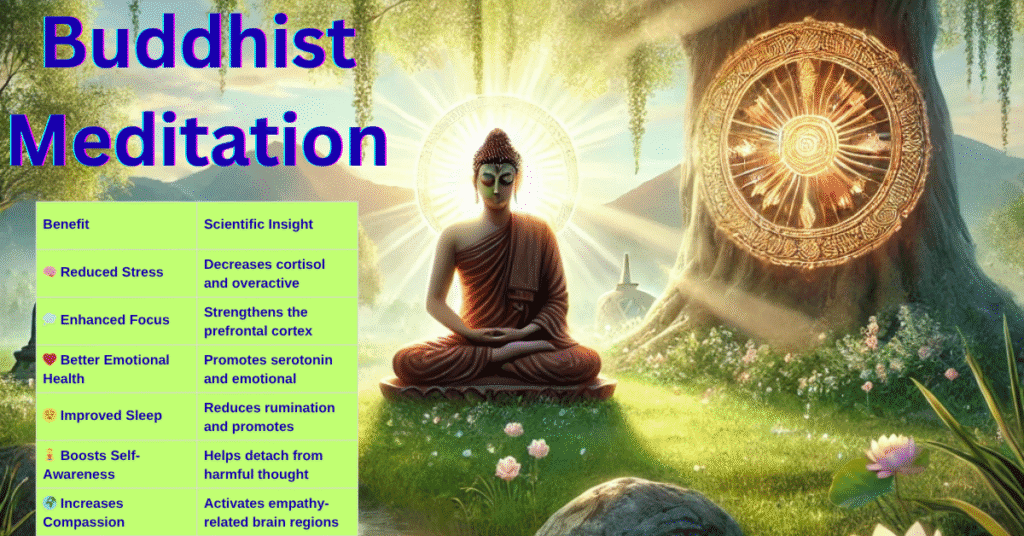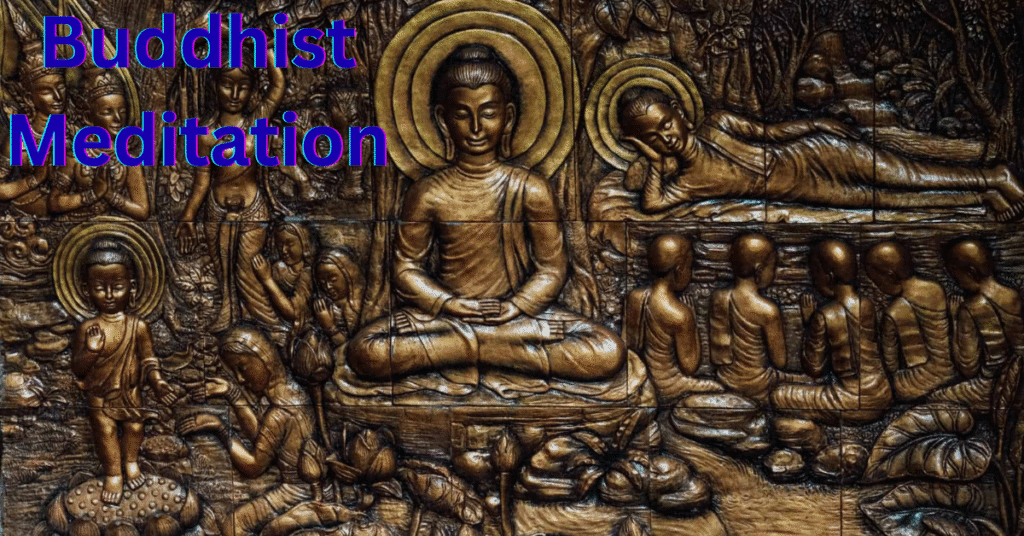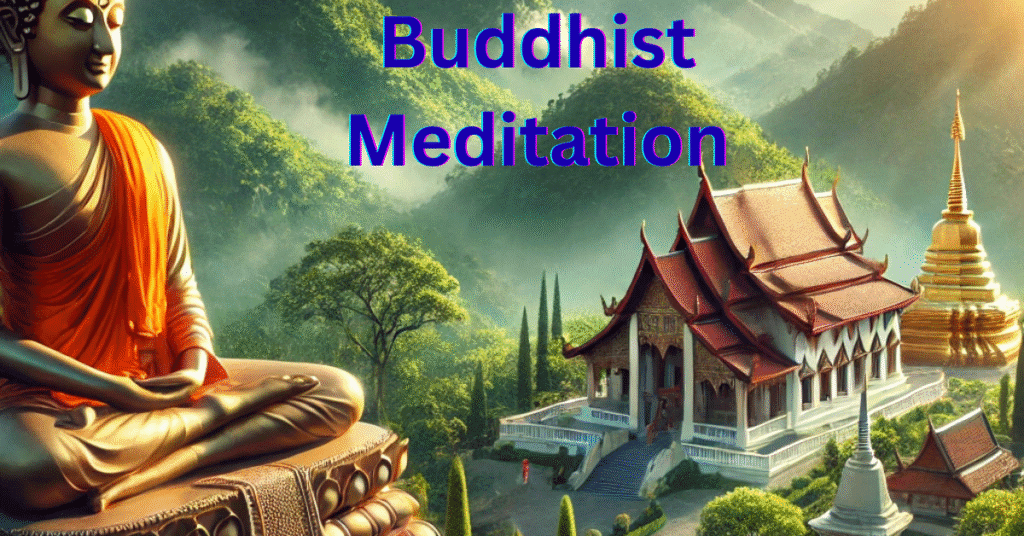
Table of Contents
Buddhist Meditation
Buddhist Meditation
Buddhist meditation is an age-old practice rooted in wisdom, mindfulness, and compassion. It is not just a tool for relaxation—it is a path of transformation that helps individuals break free from suffering and attain spiritual enlightenment.
With origins going back more than 2,500 years, this meditation system is practiced across the world in various forms, offering clarity, insight, and emotional balance to millions. In today’s fast-paced, stress-filled world, Buddhist meditation is more relevant than ever.
Discover the depth of Buddhist meditation—its history, core practices like Vipassana and Metta, modern benefits, and step-by-step guide to start today. Transform your mind and life.
📜 The Origins of Buddhist Meditation
Buddhist meditation traces its origins to Siddhartha Gautama, the historical Buddha, who lived in India around the 5th to 6th century BCE. After years of asceticism and self-inquiry, he attained enlightenment under the Bodhi tree through deep meditation.
He then taught that suffering (Dukkha) exists in all lives—but it can be understood, reduced, and even eliminated through right effort and mindfulness, primarily through meditative practices.

Meditation became central to all Buddhist schools—Theravāda, Mahāyāna, and Vajrayāna—and it continues to be the heart of Buddhism today.
🧘♂️ Goals of Buddhist Meditation
Unlike secular mindfulness practices that aim at productivity or stress relief, Buddhist meditation has spiritual goals. Its core purposes include:
- Understanding the nature of mind
- Overcoming craving and ignorance
- Developing ethical living (Sila)
- Cultivating wisdom (Prajna) and compassion (Karuna)
- Ultimately attaining Nirvana—the end of suffering
🧘♀️ Core Types of Buddhist Meditation
1. Vipassana (Insight Meditation)
One of the oldest forms, Vipassana involves observing the body, mind, and mental formations as they are—without attachment. You become aware of impermanence, suffering, and the illusion of self. This leads to liberating insight.
🧠 Widely taught today in 10-day silent retreats (as seen in S. N. Goenka’s tradition).
2. Samatha (Calm Abiding)
Samatha means “tranquility.” Here, practitioners focus on a single object, often the breath, to calm the mind. It develops strong concentration (samadhi) and prepares the ground for deeper insight.
🕯️ Used as a preparatory stage before Vipassana in many traditions.
3. Metta Bhavana (Loving-Kindness Meditation)
A powerful emotional practice, Metta cultivates unconditional love and goodwill. Starting with oneself, one extends compassion to family, friends, strangers, and eventually all sentient beings.
❤️ Scientifically proven to reduce anxiety, increase positive emotions, and improve social connection.
4. Zazen (Seated Meditation in Zen Buddhism)
Zazen means “just sitting.” It emphasizes being fully present without judgment. One simply observes thoughts and sensations arise and pass away, developing natural awareness.
🧘 Practiced in Japanese Zen and Korean Seon traditions.
5. Tonglen (Tibetan Vajrayana Practice)
Tonglen means “sending and taking.” It involves breathing in others’ pain and breathing out relief or peace. It reverses self-centeredness and deepens compassion.
🌬️ Often practiced alongside visualizations and mantra recitations in Tibetan Buddhism.
📌 Scientific Benefits of Buddhist Meditation
Modern neuroscience and psychology have confirmed what monks and sages knew centuries ago. Here are proven benefits of consistent practice:
| Benefit | Scientific Insight |
|---|---|
| 🧠 Reduced Stress | Decreases cortisol and overactive amygdala |
| 💭 Enhanced Focus | Strengthens the prefrontal cortex |
| ❤️ Better Emotional Health | Promotes serotonin and emotional regulation |
| 😌 Improved Sleep | Reduces rumination and promotes calmness |
| 🧘 Boosts Self-Awareness | Helps detach from harmful thought patterns |
| 🌍 Increases Compassion | Activates empathy-related brain regions |
🔬 Harvard, Stanford, and MIT studies have repeatedly affirmed the cognitive and emotional benefits of meditation.
🧭 Major Schools of Buddhist Meditation
◼️ Theravāda (Southern Buddhism)
- Focus: Vipassana and Metta
- Key regions: Sri Lanka, Thailand, Myanmar
- Texts: Pali Canon
- Emphasis: Self-effort, direct experience
◼️ Mahāyāna (Eastern Buddhism)
- Focus: Zen, Pure Land, and Bodhisattva ideals
- Key regions: China, Korea, Japan
- Emphasis: Compassion, emptiness (Śūnyatā), non-duality
◼️ Vajrayāna (Tibetan Buddhism)
- Focus: Visualization, Mantras, and Deity Yoga
- Key regions: Tibet, Bhutan, Mongolia
- Emphasis: Fast-track path to enlightenment using Tantric methods
📖 Buddhist Meditation and the Eightfold Path
Meditation is not a standalone practice—it’s part of the Noble Eightfold Path, which leads to the cessation of suffering.
Three elements are meditation-focused:
- Right Effort – Avoiding unwholesome states and cultivating positive ones
- Right Mindfulness – Cultivating awareness of body, feelings, mind, and phenomena
- Right Concentration – Developing deep states of mental absorption (Jhanas)
Together, these help transform the mind, leading to wisdom and liberation.
🌱 Buddhist Meditation in Modern Life

Buddhist meditation has now entered global culture—from Silicon Valley boardrooms to rural schools in Africa.
Apps like Headspace and Insight Timer, and movements like Mindfulness-Based Stress Reduction (MBSR), are inspired by Buddhist practices.
Even if you’re not a Buddhist, incorporating just 10 minutes of meditation daily can lead to:
- Better decision-making
- Emotional balance
- Reduced screen addiction
- More meaningful relationships
🌍 It’s not about becoming a monk—it’s about becoming more present and compassionate in daily life.
🙏 How to Start a Daily Buddhist Meditation Practice
Beginner’s Guide:
- Find a quiet place – Your bedroom, balcony, or garden
- Sit comfortably – Cross-legged or on a chair
- Close your eyes and bring attention to your breath
- Let thoughts come and go—don’t fight or follow them
- Start with 5–10 minutes and increase gradually
- Use guided meditations (YouTube, mobile apps, or teachers)
- Stay consistent – Regularity matters more than duration
🔔 Buddhist Quotes on Meditation
“Peace comes from within. Do not seek it without.” – Buddha
“Meditate… do not delay, lest you later regret it.” – Dhammapada
“The mind is everything. What you think you become.” – Buddha
#BuddhistMeditation, #Vipassana, #Mindfulness, #ZenMeditation, #MettaBhavana, #Samatha, #Tonglen, #SpiritualHealing, #MentalWellness, #SelfAwareness, #MeditationForBeginners, #MeditationBenefits
🌼 Conclusion: Your Journey Toward Awakening
Buddhist meditation is more than a tool—it’s a way of living, a journey of self-inquiry, compassion, and awakening. You don’t need to change your religion or retreat into the mountains. You only need a willing heart, an open mind, and a few moments each day.
Whether you’re seeking peace of mind, emotional healing, or spiritual depth, Buddhist meditation is a profound gift from the past that continues to heal the present.


